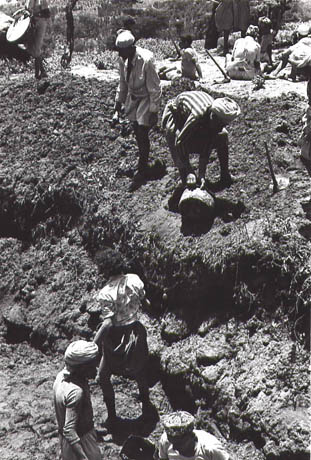
Community cleaning of cistern in al-Ahjur, 1979; photograph by Daniel Varisco
TRIBAL MEDIATION IN YEMEN AND ITS IMPLICATIONS TO DEVELOPMENT
by NAJWA ADRA, AAS WORKING PAPERS IN SOCIAL ANTHROPOLOGY
2010, Volume 19: 1–17.
Introduction
An international phenomenon that has captured the interest of scholars and international development organizations is a continued tendency to resolve conflict through indigenous methods rather than in state courts (Chirayath et al.; Corrin Care 2000; Syria-News.com; UNDP). In Yemen, as in countries as diverse as Kenya and the Solomon Islands, traditional justice is often perceived as familiar, transparent, and participatory. Its focus is reconciliation rather than punishment (Dempsey and Coburn 2010; Dimitrijevic 2006). Specifically in Yemen there is considerable flexibility and adaptability in indigenous tribal procedures and decisions, more so than one usually finds in state justice systems, and decisions are restitutive rather than coercive. Furthermore, indigenous dispute mediation, where fi nes are shared by the entire community, is less costly than the formal legal system. On the other hand, there are concerns that traditional justice may perpetuate social hierarchies by favoring the powerful or discriminating against women (Corrin Care 2000; Kameri-Mbote 2005; Kollapen 2005; Tripp n.d.). In Yemen, as elsewhere, “local strongmen†may co-opt traditional mechanisms by using force in ways that would not have been permitted historically (Dempsey and Coburn 2010). Political scientists worry that resort to traditional justice may undermine state sovereignty.
In this article, I explore these issues as they apply to self-identified tribal communities in Yemen’s Central Highlands through case studies of mediation that I collected during extensive fieldwork between 1978 and 2005 in al-Ahjur. Al-Ahjur is an agricultural community irrigated by mountain springs, about 34 km NW of Sanaa. The vast majority of its population self-identifi es as tribal (gabÄ’il, sing. gabÄ«lÄ«). The tribal population historically distinguished itself from an urban scholarly elite that includes descendants of the Prophet Muḥammad (sÄda, sing. sayyid) and from low-status service providers, such as musicians, butchers, and vegetable growers, with none of these groups defined as tribal. According to the dictates of customary law, those who are not locally defi ned as tribal are technically under tribal protection. After a brief introduction to customary law and the process of mediation, their application in rural Yemen, and disputes considered outside the jurisdiction of customary law, I will present seven case studies. Based on these cases, I discuss the importance of mediation and customary law to tribal identity…
The complete article is available as a pdf online.